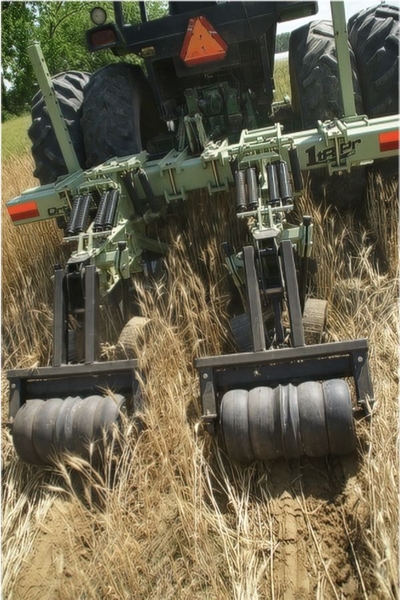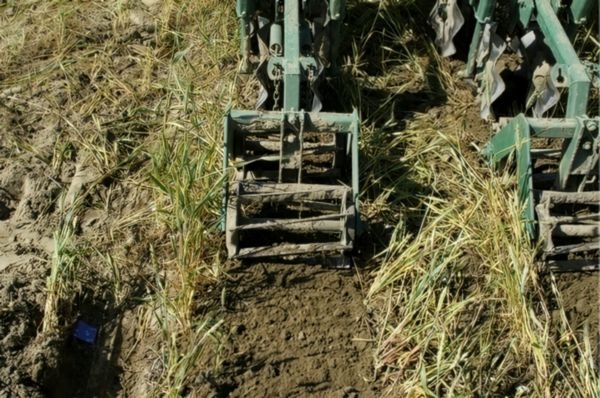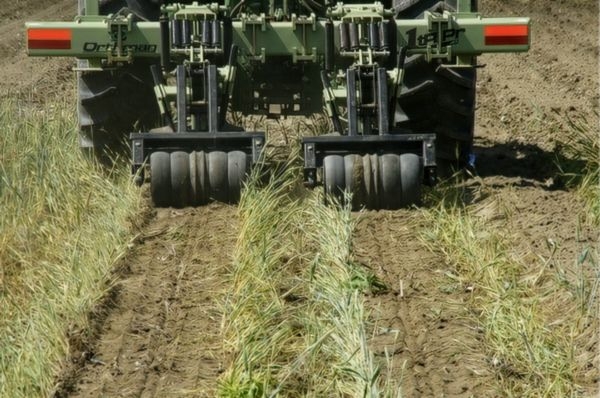Introduction
Tillage options require careful consideration, especially when you are buying new equipment. In addition to common types with a combination of a chisel plow, disk, and field cultivator, growers also have two conservation tillage equipment options available: no-till and strip-till. No-till is used extensively on soils and landscapes with erosion potential. Strip-tillage is a conservation-oriented tillage system that combines the benefits of conventional tillage and no-till farming. Strip-tillage involves tilling narrow strips of soil where the crop will be planted and leaving the rest of the field undisturbed. This provides some tillage below the seedbed for soils that need residue for erosion protection. This method can help improve soil health, reduce erosion, conserve moisture, and enhance nutrient management.
Selecting the right strip-till rig is crucial for growers in North Carolina to optimize their strip-tillage operations. Strip-tilling has two important functions: deep tillage with a ripper shank and preparation of a seed zone in a narrow strip. Strip-till should not be confused with subsoiling as a stand-alone practice. In contrast to strip-tilling, the shanks of the subsoiler may not align with the planted row and might even be run at an angle to those rows.
Many companies have at least one type of strip-till rig in their product lineup. Each type claims to offer the best tool for your farm situation. Manufacturers sometimes provide videos that demonstrate their products’ operation. Making such an important purchase requires understanding what you want and need in a strip-till unit.
If you have experience with strip-tilling, you may already know what changes you want in your next implement. If you have never strip-tilled, you might be unsure about how to evaluate a strip-till unit. Read on for some key considerations about a strip-till unit’s features and design that will help you choose the right unit for your needs (Figure 1).
Factors to Consider in Selecting a Strip-till Rig
Soil Type and Condition
It is important to consider the soil type and environmental conditions in your region. In North Carolina, the soils are diverse with sandy loams in the Coastal Plains and clayey soils in the piedmont and mountains. Select a strip-till rig that is adept at handling the particular types of soil on your farm. Evaluate the design and functionalities of the rig to ensure that they promote effective soil interaction and residue management across the diverse soil characteristics that may be present in a single field. Look for features such as adjustable row cleaners and smart-depth mechanisms that enhance the rig's flexibility in accommodating various soil textures.
Crop Rotation and Residue Management
Consider features that promote effective residue management, limit soil disturbance, and foster an environment that is useful with a diverse range of crops in rotation. Ensure that the strip-till rig is proficient in handling crop residues efficiently, while also preparing an appropriate seedbed for subsequent crops. The rig should leave enough above ground residue cover to protect the soil against erosion and to retain sufficient moisture. Evaluate the compatibility and ability of the strip-till rig to create favorable seedbed conditions for all crops in your rotation, which include cash and cover crops.
Fertilizer Placement Options
Proper nutrient placement is essential for optimizing crop growth and minimizing nutrient runoff. Assess the fertilizer placement options available with the strip-till rig. Search for rigs that offer precision placement of fertilizers near the seed zone.
Cost and Return on Investment
Analyze the total cost of the strip-till rig and the potential return on investment. Although initial costs vary, it is important to consider the long-term benefits such as improved soil health, reduced tillage costs, and the increased crop yields associated with strip-tillage practices. In addition, it is important to evaluate the durability and complexity of the maintenance requirements of the strip-till rig as well as the availability of replacement parts.
Construction and Durability
All tillage equipment is not created equal. Since tillage equipment is dragged across and through different types of soil, it is important to examine the construction of the tool (Figure 2) and consider its durability in your fields. Does your field have a thick plow layer or rocky soil? Examine what you know are weak links in any piece of equipment, such as the bearings, bolts, coulters, and chains.
Points
Points are available in a variety of shapes and designs. The shape and width of the points that are attached to the shank have the greatest effect on the upheaving of soil and the zone of soil loosening. A wider point, perhaps with wings on each side, will create a wider zone of soil loosening than a smaller, narrower point. Some manufacturers state the recommended combination of point and shank that will accomplish specific goals in soil loosening and residue management. When replacing points, be aware of the varying costs among different types. Inquire about the wear resistance of the points because some points are manufactured with increased durability.
Shank Shape
The shape of the subsoiling shank, which can range from vertical to dramatically angled forward, can affect the fracturing of soil. A vertical shank typically has a narrower soil fracturing width, which tends to leave more residue on the soil surface. This is beneficial for promoting infiltration, reducing wind and water erosion, and increasing organic matter in your soil. As the angle of the shank becomes more severe (approaching 45 degrees), the amount of soil fracturing is greater. This extends the width of the fracturing on either side but will also bury more residue and leave the ground surface rougher and less even.
Shank Reset
It is likely that your strip-till shank will hit something hard enough that you will feel this in the cab. Whether or not your shank is broken will depend on if the shank is designed to “trip.” Shank reset mechanisms vary, and the ability to trip and then reset has been a learning experience for the industry. Initially, shear bolts were used to hold shanks in place. While still present in some designs, shear bolts can be troublesome and not work well, even if they break infrequently. Newer models have “trip-reset” shanks that require lifting the implement to reset the shank, while “spring-trip” types reset automatically. There are also cost differences associated with the various shank reset options.
Strip Width
Strip-till is an important conservation tool that provides deep and shallow tillage and maintains much of the surface cover between rows. Early adopters of strip-tillage could till an area up to 12 in. across because the equipment could till only that width. Some modern strip-till rigs have a more narrow zone of tilled soil up to 6 in. wide, which allows for even more residue to remain in place.
Shank Depth
A strip-till rig cannot do what a v-ripper might do. Strip-till shanks typically do not run as deeply as a traditional ripper. It is wise to look for models that feature an adjustable depth setting on the shank. Confirm that the model you are purchasing will run as deeply (or shallow in certain soils) as you expect. When you browse the online literature, you’ll notice that many companies do not list the depth their unit will operate beneath the soil surface. It is best to call the companies to learn more about the depth expectations.
Horsepower Requirements
The amount of horsepower required to pull strip-till rigs varies with the soil type, sampling depth, and soil moisture. Horsepower options differ among brands and models. You can consider about 40 horsepower per row unit as a good starting point. A common consequence of being underpowered when performing deep tillage is raising the unit to reduce the pulling resistance. This results in the soil not being loosened to the targeted depth, which is a waste of time and money. We recommend consulting the specifications of each unit and considering the field situations on your farm in order to accurately assess your horsepower needs.
Options
Many implements have different options for shank shape, points, row firmers or soil conditioners, and fertilizer delivery systems.
Row firmers or soil conditioners: The trailing end of each row unit will include a row firmer or soil conditioner. Row firmers have rubber press wheels that press down what was elevated. A “rolling basket” is a common type of soil conditioner that breaks up clods and prepares an ideal seed zone for planting (Figure 3 and Figure 4).
Fertilizer application systems for corn and soybean: You might be able to create your own fertilizer application system in the shop, although we recommend that you investigate options available, or included, with some implements. Some units feature stainless steel tubes behind the shank that may be depth adjustable and able to deliver liquid fertilizer below the seeding depth for use by the plants as roots move deeper into the soil profile.
Additional Information
This document is not intended to recommend strip-till as the right practice for your cropping system, nor is it intended to describe recommended practices for performing strip-till in your fields. Those topics are or will be discussed in other publications available through the NC State Extension Soil Health and Management Website. For more information, please call your local North Carolina Cooperative Extension agent.
Publication date: June 5, 2024
AG-439-81
N.C. Cooperative Extension prohibits discrimination and harassment regardless of age, color, disability, family and marital status, gender identity, national origin, political beliefs, race, religion, sex (including pregnancy), sexual orientation and veteran status.




